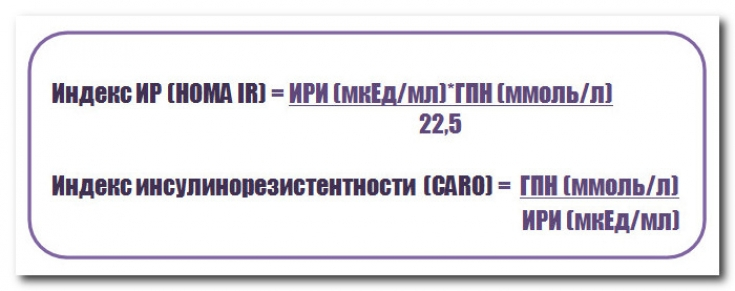If you watch your health, then most likely you have heard about the HOMA index. If you are at risk of diabetes, then you probably donated venous blood for noma index. In any case, it will be useful for every reader to know how to prevent health problems with the help of this index.
Everyone knows that insulin – one of the most important hormones produced by the pancreas to regulate metabolic processes by transporting glucose from the blood to the organs. If too little or too much insulin is produced, a type of diabetes occurs. There is also insulin resistance – a dangerous condition where the cells of the body do not respond properly to insulin, despite its normal amount.
All of these problems can be detected early on by regularly performing a HOMA test.
What is the HOMA index and how is it calculated
NOMA – is the English abbreviation of Homeostasis Model Assessment (literal translation of – homeostasis assessment model). This is an index of insulin resistance, that is, an analysis that allows you to evaluate the body's response to insulin and its production.
The HOMA index value determines the ratio of insulin and glucose values, which makes it possible to identify diabetes in the early stages.
To find out your own noma index, you need to take venous blood for analysis on an empty stomach in the morning.
HOMA formula:
Glucose (venous blood concentration mmol/l) * insulin (venous blood concentration mcU/l) / 22.5
The norm for the index number is 2.5-2.7. If your score is this, then there is nothing to worry about – the body produces insulin the way it needs to.
If the nome index is elevated, then you should not delay visiting the doctor!
Why the nome index is increased and what it means
The nome index is always elevated in people with diabetes, atherosclerosis, arterial hypertension and other cardiovascular diseases.
In addition, if your nome index is above the norm, and in addition to this you have signs of metabolic disorders, you should also see a doctor.
However, if your nome index is elevated, it does not necessarily mean that you are sick. It is possible that you simply did not prepare yourself strictly enough for the test, and your result turned out to be incorrect.

The results of the analysis for the HOMA index may be incorrect if you:
- ate later than 8 hours before blood sampling;
- did not eat in the morning, but drank any drinks other than water (tea, coffee, juice, etc.);
- overeat the evening before the test (especially if you are fond of sweet, starchy, salty or fatty);
- did not warn the doctors about taking any drugs that affect blood counts (and such drugs are the majority).
Analysis indicators for the HOMA index
|
Result Evaluation |
Capillary blood, mmol/l |
Venous blood, mmol/l |
|
NORMAL |
||
|
Fasted |
3.5 – 5.5 |
3.5 – 6.1 |
|
2 hours after eating |
<7.8 |
<7.8 |
|
PREDDIABETES (IMPAIRED GLUCOSE TOLERANCE) |
||
|
Fasted |
5,6 – 6.1 |
6,1 – 7 |
|
2 hours after eating |
7,8 – 11.1 |
7,8 – 11.1 |
|
DIABETES MELLITUS |
||
|
Fasted |
>6.1 |
>7 |
|
2 hours after eating |
>11.1 |
>11.1 |
Who needs to determine their HOMA index and why
A doctor can refer for analysis, based on the patient’s relevant complaints or anamnesis, or the patient himself can apply, knowing his own or family predisposition to a number of diseases.
Read also: Insulin resistance: how to recognize and fix the problem
Reread the list of factors that increase the noma index below. If you recognize yourself in at least a couple of points, it is better to take an analysis, find out your index and immediately exclude / confirm serious diseases.
Factors and signs of an increase in the HOMA index:
- Overeating (especially sweets)
- The concentration of fat deposits on the abdomen and waist
- Sudden weight gain
- High blood pressure (arterial)
- Constant feeling of weakness and fatigue, which is worse after dinner
- Constant wanton thirst
- Frequent urination
- Menstrual irregularities in women
- Hyperpigmentation

At risk, of course, are people whose close family members had diabetes or suffered from insulin resistance. They need to keep track of their health and HOMA index all their lives.
In addition, the risk of an increase in the index number increases if you:
- do not eat properly;
- lead a sedentary lifestyle;
- have bad habits;
- is overweight;
- often experience stress.
Nome index in gynecology – why is it especially important for women
For women, determining their index number is of particular importance, because it directly affects the hormonal background, women's health and even fertility. Not without reason now many centers of gynecology and reproductive medicine offer a blood test service for the HOMA index.
The fact is that an increased index of insulin resistance can lead to severe hormonal disruptions that provoke polycystic ovary syndrome. PCOS, in turn, often leads to a lack of ovulation, which makes it impossible to conceive a child.
See also: Polycystic ovary syndrome increases the risk of developing neoplasms
Up to 10% of women are diagnosed with PCOS. In this case, often there are not even external symptoms such as obesity.
Fortunately, PCOS is treatable, so it is possible for the patient to regain her fertility. Therefore, the noma index in gynecology – an important parameter in determining a woman's health.
How to reduce the HOMA index to normal
As you remember from the beginning of the article, insulin is produced to supply glucose to the cells of the body to saturate them with energy. The body obtains glucose from carbohydrate foods. If too much of it enters the body, then part goes into energy, and the rest – into fat (not only subcutaneous, but also visceral around the internal organs, which is much more dangerous).
Therefore, if you decide to reduce the increased noma index, then your main task – reduce the amount of carbohydrates in the diet.
This will require a special diet based on low-calorie foods, vegetables, healthy fats and lean proteins. A small amount of carbohydrates, of course, should be left on the menu, but these should be the so-called slow carbohydrates.
Read also: Advice from nutritionist Natalia Samoylenko: the basics of a healthy lifestyle
It will also be useful to have fractional meals – every 3-4 hours in small portions.
Your diet should be completely off (preferably forever):
- Sweets, pastries and sugar
- Smoked meats
- Sweet soda and packaged juices
- Fast food and convenience foods
- Canned food
Basis for the HOMA reduction diet:
- Fresh fruits (preferably unsweetened, that is, not bananas and grapes) and berries
- Vegetables, herbs - Lean meat (chicken, turkey, rabbit)
- Low-fat fish
- Cereals (buckwheat, brown rice, bulgur, etc.)
- Low-fat fermented milk products
- Whole grain bread
- Compotes and fruit drinks without sugar
Of course, it is important to drink enough clean water every day – at least two liters.

If the diet does not give enough results, it is worth consulting a doctor for prescribing special drugs.
Well, it is unnecessary to say that bad habits should be abandoned, otherwise the HOMA index will not be normalized. Stopping smoking, avoiding or at least minimizing alcohol consumption will do you good and will greatly enhance the result.
Be mindful of your daily physical activity as well. There is no need to go into professional sports at all – just try to walk every day, walk a lot, do basic exercises, spend the weekend in nature, and not on the couch – and in a few months you will be surprised at your results!






Add a comment